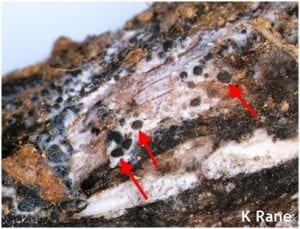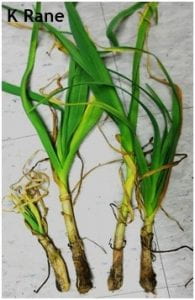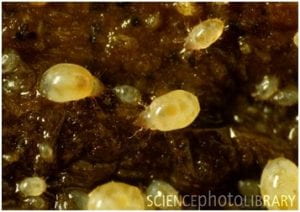Jerry Brust, IPM Vegetable Specialist, University of Maryland; jbrust@umd.edu and Karen Rane, Extension Specialist Entomology, University of Maryland rane@umd.edu
Several garlic fields have been having problems the last few years with rotting bulbs. Some seedcorn maggot was found feeding on the bulbs and we thought this was the major problem. But damage continued beyond what the maggots could do. On a second look very tiny bulb mites were found in the damaged garlic. Bulb mites are a problem of garlic and sometimes of onion that usually goes unrecognized (as in this case). These pests can reduce stands, slow plant vigor, and increase post-harvest diseases by their feeding on the roots and the stem plate. Bulb mites have a very wide host range, but cause most of their damage to onions and garlic. These mite pests are usually not seen on the bulb and prefer crawling into crevices between the roots and stem plate.
The best way to determine whether these mites are present is to carefully dissect the region where the roots and bulb come together. The mites also could be under one or two layers of scales at the lower end of the bulb. There are usually other mites present, but with a hand lens the bulb mites usually can be identified from other mites.
The mite is bulb shaped with its legs moved forward and a bulbous rear end and many long fine hairs (Fig. 1). The mouthparts and legs are purplish-brown while the main body is creamy white. These mites have been described as looking like tiny pearls with legs. The mites are extremely small (from 0.02 to 0.04 inches) and are very slow moving. They are usually found in clusters underneath scales and at the base of the roots.
It is not just the direct feeding of these mites on garlic and onions that causes problems, but also their feeding allows pathogens to enter through the wounds they create. These wounds are very good entry points for pathogens like Fusarium spp., Sclerotium cepivorum (causes the disease white rot), and various soft-rotting bacteria. The white rot fungus does best in cool temperatures, and symptoms include white fungal growth on the stem or bulb with small, dark structures called sclerotia in the decayed tissue (Fig. 2). Early in the growing season, bulb mites can cause poor plant stands and stunted growth as they feed on the plants (Fig. 3). Infested plants easily can be pulled out of the soil because of the poor root growth. Later in the season, higher than normal amounts of soft rot and Fusarium dry rot may be seen because of the wounds caused by these mites (as we saw in a couple of the garlic fields).
 Figure 1. Garlic bulb mites greatly magnified
Figure 1. Garlic bulb mites greatly magnified
Bulb mites survive in the soil on organic matter left behind from the previous crop. As long as there is decaying allium vegetable matter in the soil, bulb mites can survive in the field. The best way to control bulb mites is to allow the vegetation from the previous crop to breakdown before any new crop, especially garlic or onions are planted again. Low areas of the field that stay wet and have high levels of organic matter are especially prone to greater bulb mite survival. These mites may also come into a clean field on infested garlic cloves. The use of clean garlic clove seed or seed that has been hot water treated will control these pests. Effective hot water treatment will also, unfortunately, reduce bulb vigor.
 Figure 2. White rot (white fungus) with microsclerotia (arrows) in garlic stem
Figure 2. White rot (white fungus) with microsclerotia (arrows) in garlic stem
 Figure 3. Garlic plants damaged by bulb mite feeding and invasive fungi
Figure 3. Garlic plants damaged by bulb mite feeding and invasive fungi

